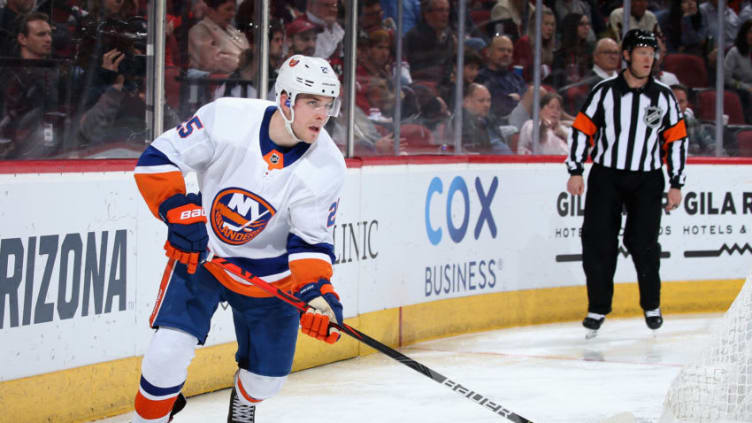Islanders 2019-20 player grade: Devon Toews didn’t have the same impact

Devon Toews didn’t have the same impact as he did in 2018-19 for the New York Islanders.
It’s easy to forget that the 2019-20 season was supposed to be Devon Toews‘s first full season in the NHL for the New York Islanders. His debut in 2018-19 didn’t happen until nearly mid-way through the season.
Called up from the Bridgeport Sound Tigers of the AHL to fill in on an injured blue line, Toews took the opportunity and ran with it. He immediately proved that he belonged in the NHL and quickly pushed his way up the Islanders depth chart.
Toews showed he’s a great puck-moving D and had great offensive upside with his performance in year one. Could he do that with increased responsibility in 2019-20?
2019-20 Expectation
Before the season started, my colleague Matt O’Leary wrote about what we should expect from Devon Toews in 19-20.
Matt stated that Toews would receive increased responsibility at 5on5 and on the power play, meaning his ice-time should move up to above 19 minutes. And with that increased ice-time we should expect to see more production from the defenseman.
He put up 18 points in 48 games in 2018-19. That paces out to 31 points over a full NHL season.
So, the expectation for Toews was to do essentially take a step forward and not back with that increased responsibility.
What Happened in 2019-20
With 1,395 minutes of ice-time, Toews averaged 20:31 of ice-time per game in 2019-20. That’s fourth in average ice-time behind Ryan Pulock (22:24), Adam Pelech (21:08), and Nick Leddy (21:07). If Adam Pelech had been healthy the full year, Toews would have likely had the third most ice-time on the blueline.
On the power play, Toews was the most used blueliner with 154:24 of total ice-time. Pulock was next with 121:57. Nick Leddy was a distant third with 70:43.
So, as Matt expected, Toews stepped up on the Islanders defensive depth chart with more responsibility at 5on5 and on the power play. Now, what did he do with that time?
In terms of production, Toews put up 28 points in 68 games. Pace out that production over a full NHL season and Toews would have ten goals and 34 points. So while that’s technically a better return than the 31 points he was on pace for in 2018-19 it’s not much better.
Comparing his advanced stats at 5on5 from last season to this season doesn’t show much improvement either:
https://twitter.com/WaveIntel/status/1258071356111048706
On the power play, the Isles improved although barely.
Something could be said about how few opportunities the Isles got. With 164 PP opportunities, they ranked last in the league by a healthy margin.
In 2018-19 the Isles held a 14.5 percent efficiency on the man advantage, through 68 games in 2019-20 they held a 17.3 percent efficiency. While better, it wasn’t much better.
For Toews, he was better on the power play when compared to 2018-19.
*All stats from NaturalStatTrick
In terms of getting the puck towards the net, he was better with an increased iFF/60. Those are unblocked shot attempts at the net. His individual scoring chances for per 60 are also up by nearly double.
Toews was fine on the power play by trying to create from the blueline but it didn’t really work out. His production (per 60) is down from last year with 0.69 goals/60 and 1.94 assists/60. Those stats were 0.69 and 2.08 respectively last season.
Want your voice heard? Join the Eyes On Isles team!
Grade: C+
I don’t think Devon Toews took a step back this season. He received nearly three minutes more ice-time per game in 2019-20 and was clearly the leader on the power play for the Isles.
I think he showed that he can do well as a second pair defenseman and as a power-play quarterback for the Isles.